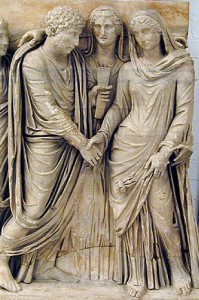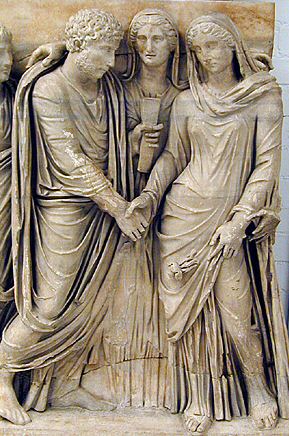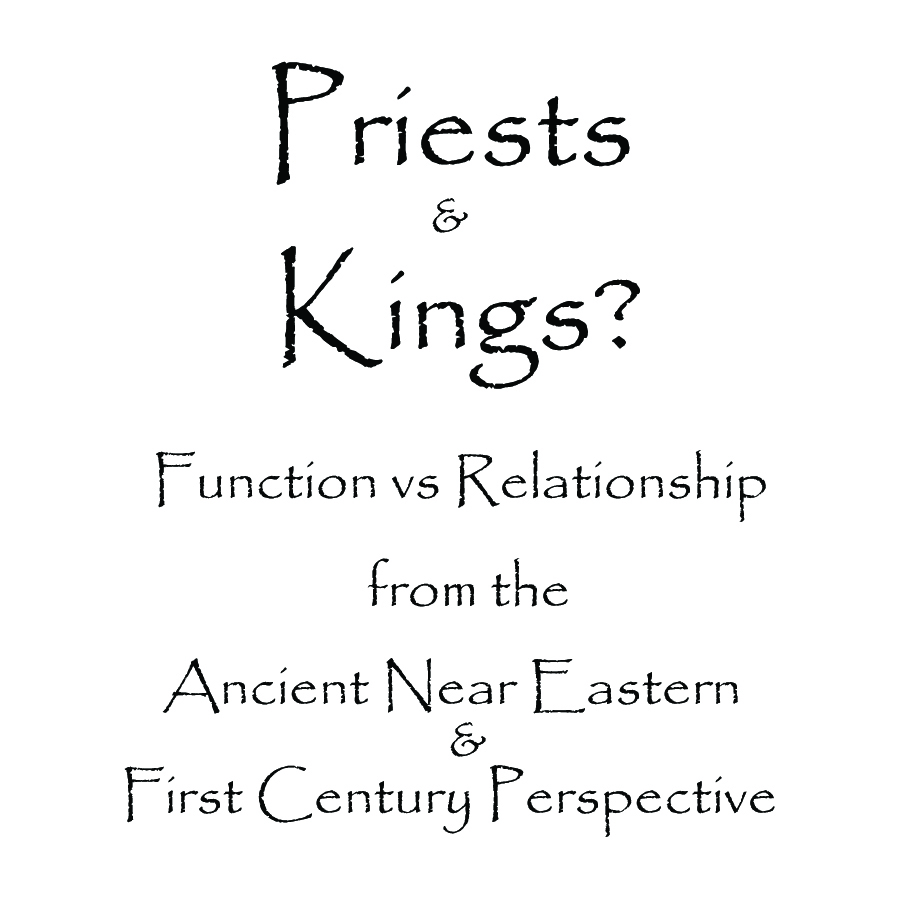First things first – this will not say whether or not women can wear them. In fact, I don’t care if people wear them. I don’t care why people wear them. Personal choices, as long as they don’t hurt anyone, are at the top of my “I don’t care” scale. I have no dog in this fight, so to speak. I don’t care if you do or do not wear head coverings any more than I care if you read Agatha Christie novels. This is simply a Biblical context study and should not be seen as anything else. Please don’t bombard me with comments about why you do it (and especially about why you think I should or should not do it too) because that is beyond the scope of this teaching – I teach context, not doctrine.
 In looking at first century Roman women’s statuary and coins, you will see three main types (I will not take into account statues of goddesses here because they are idealized and ripe in symbolism) – those that showed married women, unmarried women, and fashion icons. Married women, as in this picture of the Roman bride to the left, wore part of their garment pulled up over their heads in the same way a modern woman wears a wedding ring (although, having worded it that way, I should hope that no one actually pulls their wedding ring up over their head). Unmarried women wore their heads uncovered – as it would have been considered highly inappropriate to take upon themselves the clothing status of the married woman. In the Roman Empire, you see, fashion was heavily legislated and you could always tell a person’s status in life by how they dressed. A wife had her head covered, and the unmarried maiden had her head uncovered while her hand would be specifically placed at the hip in order to denote the protection of her virginity (as we see in the picture of this bride, who is both wife and virgin, which is why I used it). The only exceptions to the veiled/unveiled model of sculpture were in those artworks meant to promote proper and dignified hairstyles among the women of the Roman Empire. Often the Empress would be sculpted displaying the latest modest hairstyle of the day, or her image would be displayed upon coins in order to set the Imperial example for propriety – but the Empress would never actually appear in person without her veil. Which leads to the question why!
In looking at first century Roman women’s statuary and coins, you will see three main types (I will not take into account statues of goddesses here because they are idealized and ripe in symbolism) – those that showed married women, unmarried women, and fashion icons. Married women, as in this picture of the Roman bride to the left, wore part of their garment pulled up over their heads in the same way a modern woman wears a wedding ring (although, having worded it that way, I should hope that no one actually pulls their wedding ring up over their head). Unmarried women wore their heads uncovered – as it would have been considered highly inappropriate to take upon themselves the clothing status of the married woman. In the Roman Empire, you see, fashion was heavily legislated and you could always tell a person’s status in life by how they dressed. A wife had her head covered, and the unmarried maiden had her head uncovered while her hand would be specifically placed at the hip in order to denote the protection of her virginity (as we see in the picture of this bride, who is both wife and virgin, which is why I used it). The only exceptions to the veiled/unveiled model of sculpture were in those artworks meant to promote proper and dignified hairstyles among the women of the Roman Empire. Often the Empress would be sculpted displaying the latest modest hairstyle of the day, or her image would be displayed upon coins in order to set the Imperial example for propriety – but the Empress would never actually appear in person without her veil. Which leads to the question why!
Quite simply put – a married woman who went out unveiled in public was the ancient equivalent of a 21st Century married woman going to a bar without her wedding ring. She was actively expressing contempt for her marriage, and trumpeting her availability for sexual liasons. This concerned Augustus so much that he actually pronounced laws against such things – for although it was legal and expected for a man to be promiscuous and adulterous, for a woman it was a capital offense. Unless, of course, she was a prostitute – called a hetairai, a high class call girl and a perfectly legal profession.
In the first century BC, Roman wives all over the Empire began showing contempt for their marriages and their husbands by adopting the dress of hetairai – instead of dressing modestly and being industrious in the home, they turned to lives of luxurious pleasure seeking. They removed their veils, wore the purple and gold see-through clothing of prostitutes, donned pearls and gold jewelry and wore elaborate braided hairstyles. They neglected their families and the management of their home, and in order to maintain their figures they took dangerous contraceptives and even had abortions. They were both regaled and scolded by Philosophers such as Seneca, Ovid and Cicero. They were legislated against by Caesar Augustus. And unlike the modern adulterous, ringless woman in the singles bar – these women were doing it all right under their husband’s noses and often at their own dinner parties – with their husband’s own friends. The Emperor’s own niece, Julia, was tried and convicted as an adulteress and given the prescribed penalty for that crime – the shaving of her head.
But worst of all, we see these women mentioned in I Cor 11, I Tim 2 and Titus – wives and widows who forsook decency and respect in order to enjoy the same pleasures of the men of their times, but did so while members of the local assemblies! In the coming weeks, I will be exploring the impact of these shameless wives, mothers and widows on the early church assemblies and why Paul specifically rebuked those in Corinth, Ephesus and Crete for inappropriate behavior and for bringing shame to the testimony of Messiah.
In summary, head coverings were the ancient badge of being the modest Roman wife in a society where how you dressed told people exactly who you were. As head coverings no longer mean this in our greater society, and have been replaced by wedding rings in the West, golden pendants and colored bangles in Hinduism, specific hairstyles among the Zuni, white aprons in the Tibetan culture, etc. it is important to put head coverings in their place – as a personal choice and not as a doctrine that would mean anything to most of the outside world outside of Orthodox Judaism, where women cover all or some of their hair and in Haisidic communities where women cover all (and not just some) of their hair with either scarves or wigs. I Cor 11, far from being a commandment to wear head coverings, was simply telling the married women in the assemblies to act like decent married women and not like, well – whores.
So this will be an extended series – but if you can’t wait that long, I suggest an excellent resource – Bruce W Winter’s Roman Wives, Roman Widows (affiliate link, I earn commissions on qualifying purchases). For sake of brevity I cannot here lay out his level of foundational proof, the numerous historical sources he brings to the table, and the backing he has from many other scholars in the field. I am going to give you the basics, but I recommend going much deeper into the historical documents so that you can read Paul’s epistles from the vantage point of the people they were specifically written to.
Interested in more Ancient Near Eastern and First Century Context written in plain, easy to understand language? Check out my book King, Kingdom, Citizen: His Reign and Our Identity (affiliate link). Context doesn’t have to be confusing, let me make it less intimidating for you.
Part 2 here.






















Hi Tyler. Thanks for the awesome article. I wanted to ask you – Numbers 5, during the Sotah ritual, the priest had to untie / uncover the suspected adulterous woman’s hair. This is understood of course that her hair must’ve been covered initially. Was this covering also a sign of being married in ancient Israel?
Another question – on our journey as believers in Messiah – do you find that the Scriptures changes the way you live / think although it was written to another culture and different era? Cultivating a Hebrew mindset through the renewing of our minds is going to cause us to start looking like the people of the Bible. I’m somewhat caught between reading the Scriptures from a mindset that it was written to a “different people” and actually allowing that Scriptures to actually change me today, right now in my current culture.
I guess I’m trying to say that I’ve noticed that being part of Israel is a cultural thing as much as it is a faith thing. Being transformed by the renewing of our minds, but also conforming to the culture of our heavenly Bridegroom. It’s like the culture, the way they did things back then is going to affect us and we cannot stay disconnected from it –
especially if you spend time with the King.
Your thoughts will be greatly appreciated.
Much Shalom in Messiah!
head coverings were pretty much about marital status in much of the ancient world – status symbol, really. In the Sotah, it wasn’t really an uncovering of the hair so much as an unbraiding/disheveling as I recall. I read Tractate Sotah earlier in the year and it is in there and my memory is fuzzy – but the focus was on humbling the woman.
Much of Scripture absolutely boils down to culture – so we have to look at the spirit of the Law. Is slavery good or necessary anymore? Absolutely not. It served a great purpose in ancient times because it saved people from starvation and debt and gave the survivors of war an alternative to complete annihilation. In the days before the Red Cross and the Geneva convention, things were more complicated. I actually covered that in depth in my new book. The Mishnah and Gemara talk at length about how laws were kept in their day, and it was different than in the days of Moses because times had changed – what never changes is the purpose of each law, the underlying moral or humanitarian cause.
I understand what you’re saying. Thank you so much for the feedback, will keep that in mind 🙂
Hi Tyler, This makes sense although I’d like to follow up on your sources please. Would you be able to post them (or include them in the article)
Thanks
this one actually was already in the article– Bruce W Winter’s Roman Wives, Roman Widows
But I can also add Winter’s After Paul Left Corinth and Keener’s Paul, Widows and Wives.